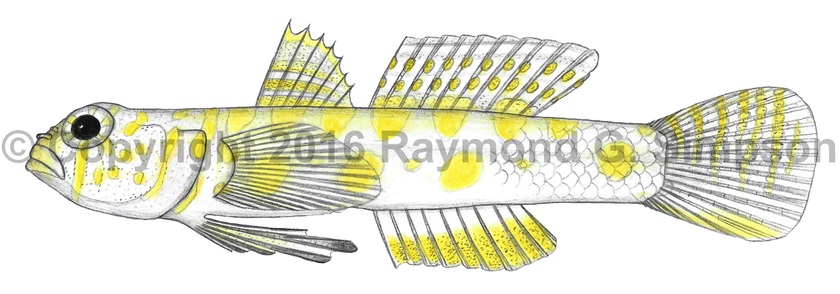
Common Name
Ocellated Splitfin Goby
Year Described
Gilmore, Van Tassell & Tornabene, 2016
Identification
Dorsal Fin: VII, 11
Anal Fin: 10
Pectoral Fin: 19-20
Caudal Fin: 17 segmented rays
Vertebrae: 11+16= 27 (total)
Body elongate with a large head. Eye medium sized. Dorsal fin with anterior spines not elongate and last two spines more spaced than the first five. Dorsal spines and first six rays with fleshy tips. Pectoral fin with lower rays elongate and reaching anal fin. Pelvic fin rays un-branched or branched and re-fused, with the last much shorter than fourth and unbranched. Pelvic rays with broad, fleshy tips. Pelvic fins not fused; extending to anal fin base. One anal-fin pterygiophore anterior to the first haemal spine. Papillae rows 5i and 5s are connected as a single row. Cephalic lateralis pores absent. Body from pectoral base to second dorsal fin covered in ctenoid scales (cycloid anteriorly) in 12-23 rows. Four or five modified scales on caudal peduncle. Two basicaudal scales present.
Color
Body pale whitish with five lateral yellow blotches and seven yellow saddles on the dorsum posterior to the first dorsal origin. Another yellow blotch on the caudal peduncle. Nape with two yellow saddles; rearmost extending onto opercle. Head with 4-6 conspicuous yellow ocellated spots on the cheek behind and below eye. Base color sprinkled heavily with red, yellow, and black melanophores. A strong yellow eyeband and other yellow spots are also present. Eye yellow. Gut and cheek with a pinkish tint. First dorsal fin with three yellow bands and thin white bands in between them. Second dorsal fin white with many yellow spots. Caudal fin white with several yellow vertical bands. Lower lobe of caudal fin yellow. Anal fin yellow with basal one third colorless. Pelvic and pectoral fin clear to pale yellow. Pelvic fin tips white.
Size
Maximum size to about 40mm SL.
Habitat
Captured on deep, sandy calcareous slopes from 110-160m.
Range
Known from the southern Lesser Antilles (St. Vincent, Barbados, and Bonaire).
References
Tornabene, L., J.L. Van Tassell, R.G. Gilmore, D.R. Robertson, F. Young, & C.C. Baldwin. 2016. Molecular phylogeny, analysis of character evolution, and submersible collections enable a new classification of a diverse group of gobies (Teleostei: Gobiidae: Nes subgroup), including nine new species and four new genera. Zoological Journal of the Linnean Society.